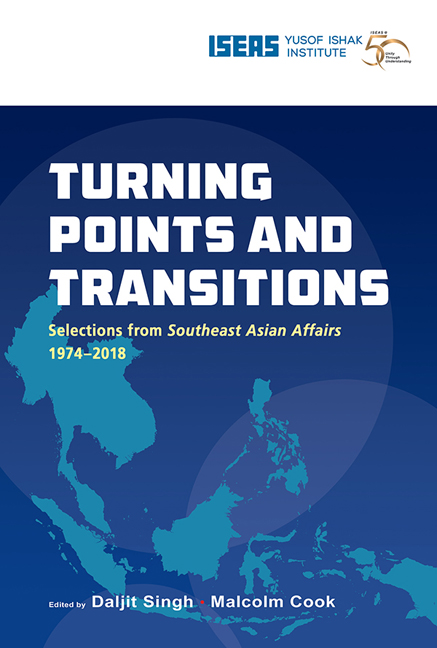Book contents
- Frontmatter
- Contents
- Message from the Director
- Foreword
- Foreword
- Introduction
- THE REGION
- BRUNEI
- CAMBODIA
- INDONESIA
- LAOS
- MALAYSIA
- MYANMAR
- THE PHILIPPINES
- SINGAPORE
- THAILAND
- The Revolutionary Situation in Thailand (1975)
- American Military Withdrawal from Thailand (1976)
- The Thai Economy: From Boom to Gloom? (1997)
- Thailand: A Year of Diminishing Expectations (1999)
- Thailand: A Reckoning with History Begins (2007)
- What Went Wrong with the Thai Democracy? (2015)
- VIETNAM
Thailand: A Reckoning with History Begins (2007)
from THAILAND
Published online by Cambridge University Press: 29 May 2019
- Frontmatter
- Contents
- Message from the Director
- Foreword
- Foreword
- Introduction
- THE REGION
- BRUNEI
- CAMBODIA
- INDONESIA
- LAOS
- MALAYSIA
- MYANMAR
- THE PHILIPPINES
- SINGAPORE
- THAILAND
- The Revolutionary Situation in Thailand (1975)
- American Military Withdrawal from Thailand (1976)
- The Thai Economy: From Boom to Gloom? (1997)
- Thailand: A Year of Diminishing Expectations (1999)
- Thailand: A Reckoning with History Begins (2007)
- What Went Wrong with the Thai Democracy? (2015)
- VIETNAM
Summary
Introduction: Wat Thepsirin, 12 November 2006
On the clear, sunny afternoon of 12 November 2006, a sliver of Bangkok's great, good, and merely loyal gathered at Wat Thepsirintharawat Ratchaworawihan to participate in the royally sponsored cremation rites for General Kriangsak Chomanan. Thailand's prime minister during 1977–80, Kriangsak had passed away in late 2003. Three years on, his cremation offered a rare, even reassuring moment of calm and order during a year of disorientating and discouraging developments for Thailand.
Thais present at Wat Thepsirin included a number of those who had shaped recent history. Former Foreign Minister Air Chief Marshal (Retired) Siddhi Savetsila attended the cremation. So did former Prime Minister Chuan Leekpai and several of the leading technocrats of the late 1970s and early 1980s. Dhanin Chearavanont of the Charoen Pokphand (CP) Group was also present — perhaps in recognition of Kriangsak's engagement with the People's Republic of China, where CP was an important early foreign investor, during his tenure as premier.
For all their reminders of yesteryear, the rites had a particularly timely aspect, too. Not least, they came less than two months after a military coup in Bangkok, executed on 19 September 2006. In his time, Kriangsak had been no stranger to coups. He was a leading participant in the October 1976 coup that ended Thailand's three-year experiment with open democratic politics. A year later, the extreme rightist orientation of judge Thanin Kraivixien's government led Kriangsak to lead a further coup, this time without prior royal approval, and to assume the premiership himself. During his years in office, Kriangsak moved to limit the political influence of the rightwing, pro-monarchist mass movement, the Village Scouts. Determined to place the Thai monarchy truly above politics and convinced of the need for a systematic approach to the challenges facing the country, he consulted with the King only minimally. This determination is said to have earned him the lasting dislike of the palace.
With no member of the royal family present, and in the King's stead, Privy Council president General (Retired) Prem Tinsulanonda presided over the 12 November cremation rites. His role was not without irony.
- Type
- Chapter
- Information
- Turning Points and TransitionsSelections from Southeast Asian Affairs 1974-2018, pp. 678 - 701Publisher: ISEAS–Yusof Ishak InstitutePrint publication year: 2018

